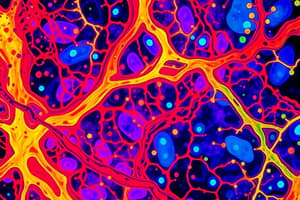Podcast
Questions and Answers
Which cellular change is characterized by swollen cells with granular cytoplasm and a normal nucleus?
Which cellular change is characterized by swollen cells with granular cytoplasm and a normal nucleus?
- Cellular swelling
- Fatty change
- Cloudy swelling (correct)
- Hydropic degeneration
In which organs does hydropic degeneration commonly occur?
In which organs does hydropic degeneration commonly occur?
- Brain, bone marrow, and skin
- Lungs, spleen, and pancreas
- Renal tubules, cardiac muscles, and hepatocytes (correct)
- Stomach, intestines, and gallbladder
What is the characteristic feature of fatty change in cells?
What is the characteristic feature of fatty change in cells?
- Presence of swollen cells with granular cytoplasm
- Abnormal accumulation of intracellular neutral fat (correct)
- Increased cell size with vacuolated cytoplasm
- Formation of water-filled vacuoles in the cytoplasm
What is the common light microscopic change associated with reversible cell injury?
What is the common light microscopic change associated with reversible cell injury?
What are the macroscopic characteristics of an organ undergoing hydropic degeneration?
What are the macroscopic characteristics of an organ undergoing hydropic degeneration?
Flashcards
Cloudy Swelling
Cloudy Swelling
Swollen cells with granular cytoplasm and a normal nucleus.
Hydropic Degeneration Organs
Hydropic Degeneration Organs
Renal tubules, cardiac muscles, and hepatocytes.
Fatty Change
Fatty Change
Abnormal accumulation of intracellular neutral fat.
Reversible Cell Injury Change
Reversible Cell Injury Change
Signup and view all the flashcards
Hydropic Degeneration Organ Characteristics
Hydropic Degeneration Organ Characteristics
Signup and view all the flashcards
Study Notes
Causes of Cell Injury
- Living irritants: infections
- Non-living: trauma, physical injury (thermal, radiation), chemical injury, immunological injury, hypoxia (anemia, inadequate oxygen, ischemia)
Reversible Injury
- Mitochondrial oxidative phosphorylation disrupted → Decreased ATP
- Decreased ATP leads to:
- Decreased Na/K pump → gain of intracellular Na → cell swelling
- Decreased ATP-dependent Ca pumps → increased cytoplasmic Ca concentration
- Lactic acid accumulation → decreased pH
- Detachment of ribosomes from RER → decreased protein synthesis
- End result: cytoskeletal disruption with loss of microvilli, bleb formation, etc.
Role of Mitochondria in Cell Injury
- Mitochondria responsible for:
- Cell respiration
- Production of ATP
- Vital functions of the cell:
- Cellular osmolarity (Na/K)
- Membrane transport process
- Protein synthesis
Reversible Mitochondrial Changes in Cell Injury
- Mild injury: swollen mitochondria
- Normal mitochondria
- Severe injury:
- Rupture of mitochondrial membrane
- Myelin figure (remnants of mitochondrial membrane)
- Calcification of mitochondrial remnants
Studying That Suits You
Use AI to generate personalized quizzes and flashcards to suit your learning preferences.




